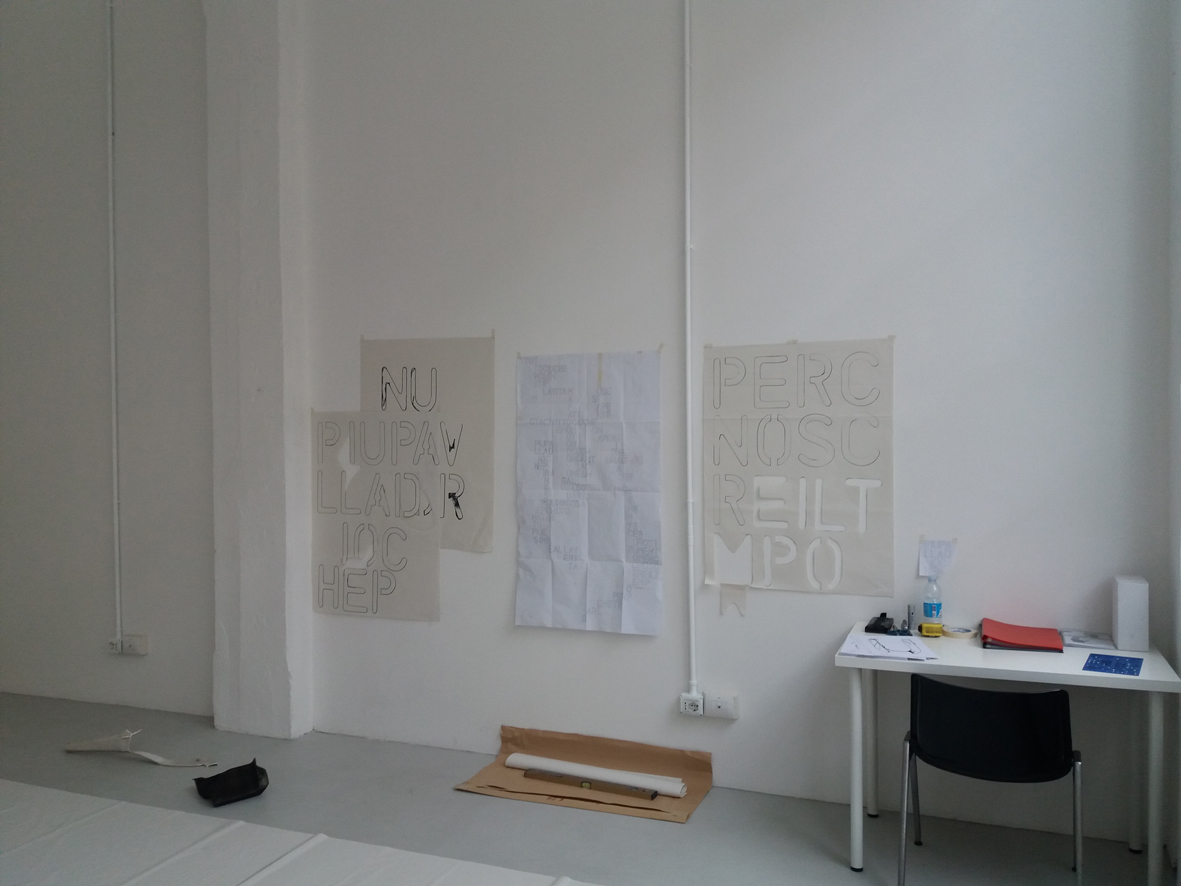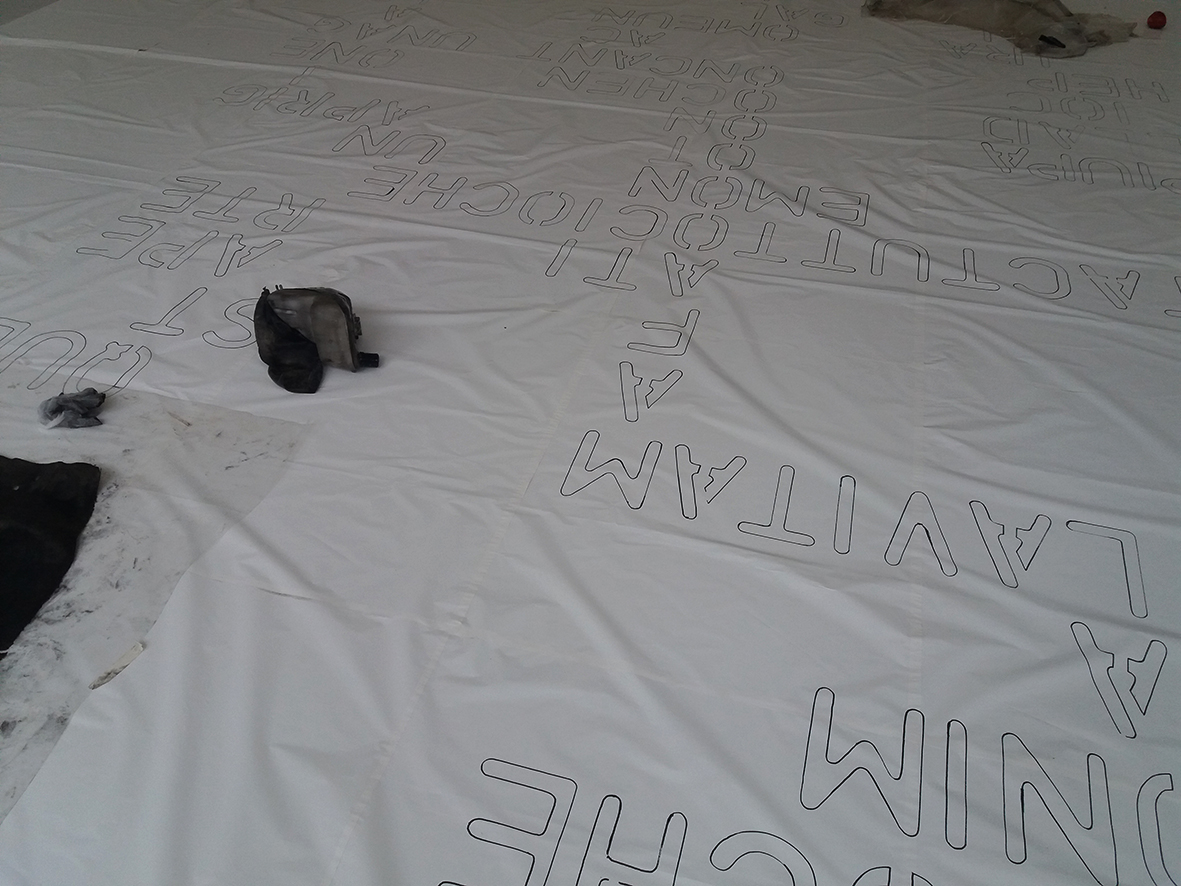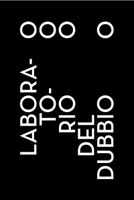
LDD 05
LDD 05 | Giugno 2016
Giulia Cenci + Marco Mazzoni + Valerio Del Baglivo
Bez Nazvaniya
23 giugno 2016 – finissage
“Secondo secolo dopo la nostra èra.
Cella di Publio e Tullio: un ambiente ideale per due, una via di mezzo tra un monolocale e la cabina di un’astronave. Scenografia: più Palladio che Piranesi. la vista dalla finestra deve dare una sensazione di notevole altezza dal momento che la prigione è situata in una enorme Torre d’acciao, alta circa un chilometro.
[…]
Al centro della cella una colonna -o pilastro- in stile pseudo-dorico, all’interno di questa un ascensore. La colona attraversa la Torre come un perno un asse. Ed è in effetti un perno: tutto ciò che appare o scompare dalla scena nel corso della rappresentazione, appare e scompare attraverso un’apertura nella colonna, un incrocio tra un calapranzi e un condotto per la spazzatura.
[…]
La cella è dotata di ogni comfort: vasca da bagno, tavolo, lavandino, W.C., telefono, schermo televisivo incassato nel muro, scaffali con libri. Sugli scaffali e nelle nicchie alle pareti, busti di autori classici.
E’ mezzogiorno.
[…]
PUBLIO: Bè… l’azione. Il fatto. Tutto al mondo è determinato da quello che viene prima e da quello che viene dopo. Senza un prima e un dopo un fatto non è un fatto.
TULLIO: E allora cos’è?
PUBLIO: E che ne so! Un’attesa. La condizione del “prima”. Oppure un “dopo” tirato per le lunghe.
TULLIO: Barbaro! Inguaribile, insopportabile barbaro! E ha pure il coraggio di ordinarsi Orazio!
PUBLIO: Piantala di latrare!
TULLIO: Io latrare? Barbaro, ottuso, dissennato barbaro! Perché un fatto senza un prima e un dopo è il Tempo. Puro e semplice. un segmento di Tempo. Una parte-ma di Tempo. Qualcosa che non ha né causa né effetto. Ergo – la Torre. Ergo – noi nella Torre. E così anche le telecamere. tutto quanto avviene nella Torre è Tempo puro. Nella sua variante, per così dire, incontaminata. Come nel vuoto.
[…]
Questa per te è una prigione, una galera […] Per me, invece, è uno strumento per conoscere il Tempo. Per penetrarlo… E, bada bene, è uno strumento perfetto: con tutto quello che serve alla sopravvivenza.”*
*Iosif Brodskij, Marmi, Traduzione di Fausto Malcovati. Adelphi Edizioni, Milano 1995.
Nessuna volontà di usare la sceneggiatura come tale ma di muoversi, agire e creare dentro un perimetro/Torre: uno spazio dove quello che accade non ha conseguenze, dove il peso delle cose resta invariato. Tutto ciò che lo attraversa cambia, muta, perde una forma per acquisirne un’altra, più necessaria e urgente ad un frammento di Tempo. Ogni gesto, ogni azione, ogni desiderio -proprio come nella “Torre”- lascia una traccia: una “registrazione” che diviene nota che diversifica un secondo dall’altro, il segno che connota un frammento di spazio.















*
16 giugno 2016 – reading
‘Iosif Brodskij Marbles Reading’
Lettura in situ di ‘Marmi’, di Josif Brosdkji, premio Nobel per la Letteratura 1987. Un omaggio all’omaggio dei due artisti residenti al Laboratorio del Dubbio, Giulia Cenci e Marco Mazzoni. Interpretazione dal russo di Lidiya Liberman.

*
9 giugno 2016 – open studio









*
GIULIA CENCI (1988) vive e lavora ad Amsterdam dove sta frequentando il programma di residenza DeAteliers. Tra le mostre personali e collettive recenti: Mai, Tile projectspace, Milano, La Terra Bassa, SpazioA, Pistoia, If you want me again look for me under your boot-soles, a cura di Qinyi Lim, Present Future, Artissima, Torino; The Lasting. L’intervallo e la durata, a cura di Saretto Cincinelli, Galleria Nazionale d’Arte Moderna, Roma (upcoming), Inside David’s Thigh, a cura di Nicola Martini, Room Service, New York, Ripensare il medium: il fantasma del disegno, a cura di Saretto Cincinelli and Cristiana Collu, Casa Masaccio, San Giovanni Valdarno, Moroso Concept for Contemporary Art, a cura di Andrea Bruciati, Villa Manin, Codroipo, Biennale giovani Monza, a cura di Fabio Cavallucci, Palazzo dell’Argentario, Monza, Lumination, a cura di Alex Bacon, Patricia Low Contemporary, Gstaad, Le leggi dell’ospitalità, a cura di Antonio Grulli, P420 Gallery, Bologna, Still Light, a cura di Taru Elfving, Augusta Gallery, Hiap, Helsinki.
MARCO MAZZONI è coreografo, performer e artista visivo, si forma nelle arti performative a Firenze con Antonietta Daviso e a New York presso il Merce Cunningham Studio. Nel 1995 fonda Kinkaleri, collettivo di artisti che si occupa di arti della scena e con cui tuttora collabora, parallelamente sviluppa una propria ricerca personale nelle arti visive, nel 2013 fonda il progetto editoriale indipendente mazoopub pubblicando una serie di fanzine ad uscita periodica.
VALERIO DEL BAGLIVO (*1979) è un curatore indipendente, educatore e perenne collaboratore di base a Londra. Al momento sta concludendo un dottorato di ricerca presso la Middlesex University con una ricerca sui programmi di coinvolgimento del pubblico e di pedagogia sperimentale in istituzioni artistiche indipendenti. Ha curato mostre e progetti per organizzazioni come Isola Art Center – Milano, Konsthall C – Stoccolma, Apexart – NY, Kunstverein – Milano, Kunsthalle Exengrasse – Vienna. E ‘ membro di IKT – International Association of Curatori di Arte Contemporanea.
—
english version below
LDD 05 | June 2016
Giulia Cenci + Marco Mazzoni + Valerio Del Baglivo
Bez Nazvaniya
“ Second century after our era.
Cell of Publius and Tullius: an ideal space for two, halfway between a studio apartment and a spaceship cabin. Set: more Palladio than Piranesi. The view from the window should give the impression of great height, since the prison is located in an enormous steel Tower, about one kilometer in height.
[…]
There is a column – or pillar – in pseudo-Doric style, containing an elevator, at the center of the cell. The column crosses the Tower as a bolt crosses a board. And, in effect, it is a bolt: everything that appears or vanishes from the scene during the performance does so through an opening in the column, a cross between a dumbwaiter and a garbage chute.
[…]
The cell has all the comforts: bathtub, table, washstand, toilet, telephone, TV screen built into the wall, shelves with books. Busts of classical authors stand on the shelves and in wall niches.
It’s noontime.
[…]
PUBLIUS: Well then… the action. The fact. The whole world is determined by what comes before and what comes after. Without a before-and-after a fact is not a fact.
TULLIUS: So what is it?
PUBLIUS: How should I know? An expectation. The condition of “before.” Or an “after” that drags on.
TULLIUS: Heathen! Hopeless, unbearable heathen! And he has the nerve to ordain himself Horace!
PUBLIUS: Quit your yapping!
TULLIUS: Me, yapping? Heathen, obtuse, unhinged heathen! Because a fact without a before-and-after is Time. Pure and simple. A segment of Time. A part – but of Time. Something that has no cause, no effect. Ergo – the Tower. Ergo – us in the Tower. So too the video cameras. Everything that happens in the Tower is pure Time. In, so to speak, its uncontaminated variant. As in the void.
[…]
For you this is a prison, a jail […] For me, on the other hand, it is a tool to know Time. To penetrate it… And, mark my words, it is a perfect tool: which everything that is needed for survival.”*
*Joseph Brodsky, Marbles.
No intention to use the play as such but to move, to act and create inside a perimeter/Tower: a space where what happens has no consequences, where the weight of things remains the same. Everything that crosses it changes, alters, loses one form to take on another, more necessary and urgent to a fragment of Time. Every gesture, action, desire – precisely as in the “Tower”- leaves a trail: a “recording” that becomes known, that differentiates one second from another. The sign that connotes a fragment of space.
—
‘Iosif Brodskij Marbles Reading’
Reading in situ of ‘Marmi’, a text by Josif Brosdkji, Nobel for Literature 1987. An homage to the resident artists’s homage, Giulia Cenci and Marco Mazzoni. Interpretation from Russian language by Lidiya Liberman.
*
GIULIA CENCI ((1988) lives and works in Amsterdam where she is participating in a residency program at DeAteliers. Recent solo and group shows include: (solo) Mai, Tile projectspace, Milan, La Terra Bassa, SpazioA, Pistoia, If you want me again look for me under your boot-soles, curated by Qinyi Lim, Present Future, Artissima, Turin; (group) The Lasting. L’intervallo e la durata, curated by Saretto Cincinelli, Galleria Nazionale d’Arte Moderna, Rome (upcoming), Inside David’s Thigh, organized by Nicola Martini, Room Service, New York, Ripensare il medium: il fantasma del disegno, curated by Saretto Cincinelli and Cristiana Collu, Casa Masaccio, San Giovanni Valdarno, Moroso Concept for Contemporary Art, curated by Andrea Bruciati, Villa Manin, Codroipo, Biennale giovani Monza, curated by Fabio Cavallucci, Palazzo dell’Argentario, Monza, Lumination, curated by Alex Bacon, Patricia Low Contemporary, Gstaad, Le leggi dell’ospitalità, curated by Antonio Grulli, P420 Gallery, Bologna, Still Light, curated by Taru Elfving, Augusta Gallery, Hiap, Helsinki.
MARCO MAZZONI is a choreographer, performer and visual artist; he trained in performing arts in Florence with Antonietta Daviso and in New York at the Merce Cunningham Studio. In 1995 he founded Kinkaleri, a group of artists focusing on theatrical arts, with whom he still collaborates. Parallel to this, he has developed his own personal research in the visual arts; in 2013 he founded the independent publishing project mazoopub, creating a series of periodically published fanzines.
VALERIO DEL BAGLIVO (1979) is an independent curator, educator and constant collaborator based in London. At the moment he is completing a research doctorate at Middlesex University with a study on programs of audience participation and experimental pedagogy in independent art institutions. He has curated exhibitions and projects for organizations like Isola Art Center – Milan, Konsthall C – Stockholm, Apexart – NY, Kunstverein – Milan, and has participated in international residencies at The Banff Centre in Banff, ICC at the Gwangju Biennial in South Korea, Wysing Art Centre in Cambridge and Futura in Prague. He is a member of IKT – International Association of Contemporary Art Curators. In recent years he has organized public programs that involve the combination of educational moments – lectures, conferences, workshops – with performative elements to foster innovative participation-based curatorial approaches.
*
(ph. Giulia Cenci, Marco Mazzoni, Sara Enrico)
